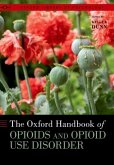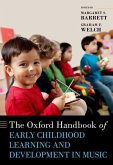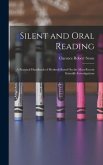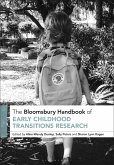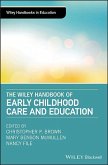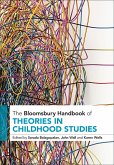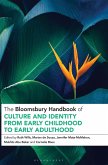The Oxford Handbook of Nonsuicidal Self-Injury
Herausgeber: Lloyd-Richardson, Elizabeth E; Whitlock, Janis L; Baetens, Imke
The Oxford Handbook of Nonsuicidal Self-Injury
Herausgeber: Lloyd-Richardson, Elizabeth E; Whitlock, Janis L; Baetens, Imke
- Gebundenes Buch
- Merkliste
- Auf die Merkliste
- Bewerten Bewerten
- Teilen
- Produkt teilen
- Produkterinnerung
- Produkterinnerung
The Oxford Handbook of Nonsuicidal Self-Injury is a compendium of up-to-date research and knowledge of topics germane to the field of nonsuicidal self-injury (NSSI). Edited by renowned scholars Elizabeth E. Lloyd-Richardson, Imke Baetens, and Janis L. Whitlock, the handbook brings together cutting-edge research from a group of internationally distinguished scholars. It covers a wide array of topics including epidemiology, function, neurophysiological processes, lived experience, and intervention and prevention approaches. This comprehensive text will serve as a go-to guide for scholars,…mehr
Andere Kunden interessierten sich auch für
![The Oxford Handbook of Opioids and Opioid Use Disorder The Oxford Handbook of Opioids and Opioid Use Disorder]() The Oxford Handbook of Opioids and Opioid Use Disorder272,99 €
The Oxford Handbook of Opioids and Opioid Use Disorder272,99 €![The Oxford Handbook of Early Childhood Learning and Development in Music The Oxford Handbook of Early Childhood Learning and Development in Music]() The Oxford Handbook of Early Childhood Learning and Development in Music242,99 €
The Oxford Handbook of Early Childhood Learning and Development in Music242,99 €![Silent and Oral Reading: A Practical Handbook of Methods Based On the Most Recent Scientific Investigations Silent and Oral Reading: A Practical Handbook of Methods Based On the Most Recent Scientific Investigations]() Clarence Robert StoneSilent and Oral Reading: A Practical Handbook of Methods Based On the Most Recent Scientific Investigations38,99 €
Clarence Robert StoneSilent and Oral Reading: A Practical Handbook of Methods Based On the Most Recent Scientific Investigations38,99 €![The Bloomsbury Handbook of Early Childhood Transitions Research The Bloomsbury Handbook of Early Childhood Transitions Research]() The Bloomsbury Handbook of Early Childhood Transitions Research219,99 €
The Bloomsbury Handbook of Early Childhood Transitions Research219,99 €![The Wiley Handbook of Early Childhood Care and Education The Wiley Handbook of Early Childhood Care and Education]() The Wiley Handbook of Early Childhood Care and Education230,99 €
The Wiley Handbook of Early Childhood Care and Education230,99 €![The Bloomsbury Handbook of Theories in Childhood Studies The Bloomsbury Handbook of Theories in Childhood Studies]() The Bloomsbury Handbook of Theories in Childhood Studies201,99 €
The Bloomsbury Handbook of Theories in Childhood Studies201,99 €![The Bloomsbury Handbook of Culture and Identity from Early Childhood to Early Adulthood The Bloomsbury Handbook of Culture and Identity from Early Childhood to Early Adulthood]() The Bloomsbury Handbook of Culture and Identity from Early Childhood to Early Adulthood201,99 €
The Bloomsbury Handbook of Culture and Identity from Early Childhood to Early Adulthood201,99 €-
-
-
The Oxford Handbook of Nonsuicidal Self-Injury is a compendium of up-to-date research and knowledge of topics germane to the field of nonsuicidal self-injury (NSSI). Edited by renowned scholars Elizabeth E. Lloyd-Richardson, Imke Baetens, and Janis L. Whitlock, the handbook brings together cutting-edge research from a group of internationally distinguished scholars. It covers a wide array of topics including epidemiology, function, neurophysiological processes, lived experience, and intervention and prevention approaches. This comprehensive text will serve as a go-to guide for scholars, clinicians, and anyone with interest in understanding, treating, and preventing self-injury.
Hinweis: Dieser Artikel kann nur an eine deutsche Lieferadresse ausgeliefert werden.
Hinweis: Dieser Artikel kann nur an eine deutsche Lieferadresse ausgeliefert werden.
Produktdetails
- Produktdetails
- Verlag: Hurst & Co.
- Seitenzahl: 1296
- Erscheinungstermin: 6. Mai 2024
- Englisch
- Abmessung: 271mm x 192mm x 60mm
- Gewicht: 2131g
- ISBN-13: 9780197611272
- ISBN-10: 0197611273
- Artikelnr.: 67733560
- Herstellerkennzeichnung
- Libri GmbH
- Europaallee 1
- 36244 Bad Hersfeld
- gpsr@libri.de
- Verlag: Hurst & Co.
- Seitenzahl: 1296
- Erscheinungstermin: 6. Mai 2024
- Englisch
- Abmessung: 271mm x 192mm x 60mm
- Gewicht: 2131g
- ISBN-13: 9780197611272
- ISBN-10: 0197611273
- Artikelnr.: 67733560
- Herstellerkennzeichnung
- Libri GmbH
- Europaallee 1
- 36244 Bad Hersfeld
- gpsr@libri.de
Elizabeth E. Lloyd-Richardson, PhD, is a Professor of Psychology at the University of Massachusetts Dartmouth, conducting research in areas of health behavior change, such as improving young adults' health, wellness, and resilience skills, and reducing self-harm behaviors. Imke Baetens, PhD, is an Associate Professor in the Faculty of Psychology and Educational Sciences at Vrije Universiteit Brussel, Belgium, and a licensed family therapist. She is also the Founder and Academic Director of the Brussels Consultation Center (BRUCC). Baetens specializes in behavioral and emotional problems in adolescence. Janis L. Whitlock, PhD, is the Founder and Director of the Cornell Research Program on Self-Injury and Recovery. She is also Research Scientist Emerita at Cornell University and currently consults with schools, organizations, and individuals interested in enhancing the mental health and well-being of adolescents and young adults.
* Chapter 1: Introduction
* Elizabeth Lloyd-Richardson, Imke Baetens, and Janis Whitlock
* Chapter 2: NSSI in the DSM-5
* Greg Lengel, Brooke A. Ammerman, and Jason Washburn
* Chapter 3: A Comparison of the Theoretical Models of NSSI
* Kirsty Hird, Penelope Hasking, and Mark Boyes
* Chapter 4: Direct and Indirect Self-Injury
* Lotte Rubæk and Bo Møhl
* Chapter 5: Theoretical Models Linking NSSI to Suicide
* Sarah E. Victor, Kirsten Christensen, and Terry H. Trieu
* Chapter 6: The Functions of Nonsuicidal Self-Injury
* Peter James Taylor, Katie Dhingra, Kelly-Marie Peel-Wainwright, and
Kathryn Jane Gardner
* Chapter 7: The Epidemiology of Nonsuicidal Self-Injury and Self-Harm
in Non-Clinical Samples: Population-Level Trends
* Louise Staring, Glenn Kiekens, and Olivia J. Kirtley
* Chapter 8: Overview and Epidemiology of NSSI in Clinical Samples
* Jennifer J. Muehlenkamp and Victoria Tillotson
* Chapter 9: NSSI and Self-Harm Behavior and the COVID-19 Pandemic
* Amy Brausch and Rebekah Clapham
* Chapter 10: Cross-Cultural Representations of NSSI
* Marc Stewart Wilson
* Chapter 11: Stairway to Heaven: NSSI as an Addiction
* Hilario Blasco-Fontecilla
* Chapter 12: A Roadmap Overview of the Research Domain Criteria
(RDoC): A Shift from Diagnostic to Transdiagnostic Processes
* Tim Bastiaens and Laurence Claes
* Chapter 13: Negative Affect and Nonsuicidal Self-Injury
* Benjamin A. Swerdlow, Jennifer G. Pearlstein, Devon B. Sandel, and
Sheri L. Johnson
* Chapter 14: The Brain and Body's Threat System Functioning in Those
With NSSI
* Katherine A. Carosella, Andrea Wiglesworth, Zeynep Basgöze, Kathryn
R. Cullen, and Bonnie Klimes-Dougan
* Chapter 15: Positive Valence Systems and Nonsuicidal Self-Injury
* Laurence Claes, Koen Luyckx, and Glenn Kiekens
* Chapter 16: Cognitive Systems in NSSI and Co-Occurring Conditions
* Morgan E. Browning and Jennifer J. Muehlenkamp
* Chapter 17: Social Processes in Nonsuicidal Self-Injury
* Maria Zetterqvist and Johan Bjureberg
* Chapter 18: Autonomic Nervous System Function in Nonsuicidal
Self-Injury - A Research Domain Criteria Perspective on the
Arousal/Regulatory Systems
* Christine Sigrist, Michael Kaess, and Julian Koenig
* Chapter 19: Bridging Brain and Behavior: Using Biology to Inform NSSI
Interventions
* Mindy Westlund Schreiner, Summer B. Frandsen, Nicolette C. Molina,
and Alina K. Dillahunt
* Chapter 20: Lived Experience Perspectives on Self-Injury: Current
Evidence and Practical Applications
* Penelope Hasking, Therese E. Kenny, and Stephen P. Lewis
* Chapter 21: Beyond "Stopping": Reconceptualizing NSSI Recovery in
Favor of Healing and Growth
* Janis Whitlock, Josie Woolsen, and Elizabeth Lloyd-Richardson
* Chapter 22: The Dynamics and Perception of Pain During NSSI
* Edward A. Selby and Christopher Hughes
* Chapter 23: The Role of Self and Blood in Ritual and Non-Ritual
Self-Injury
* Annette Hornbacher, William Sax, Janina Naoum, and Christian Schmahl
* Chapter 24: The Significance of Site of Self-Injury
* Kathryn Jane Gardner, Caroline Clements, Harriet Bickley, Gillian
Rayner, and Peter James Taylor
* Chapter 25: NSSI in Elementary School Children
* Lisa Van Hove, Imke Baetens, Amanda Simundic, Elana Bloom, and Nancy
Heath
* Chapter 26: NSSI in Adolescence and Emerging Adulthood
* Glenn Kiekens, Penelope Hasking, and Laurence Claes
* Chapter 27: Understanding and Working With Adults who Self-Injure
* Margaret Andover, Hae-Joon Kim, Vincent Corcoran, Michelle Hiner, Ana
Rabasco, and Joshua DeSon
* Chapter 28: Understanding and Treating Atypical, Severe Nonsuicidal
Self-Injury
* Barent W. Walsh, Leonard Doerfler, and Lisa Van Hove
* Chapter 29: NSSI in Older Adults
* Lisa Van Hove, Imke Baetens, Chloe A. Hamza, Eva Dierckx, An Haekens,
Lila Fieremans, and Steven Vanderstichelen
* Chapter 30: What Do US National Data Tell Us About People With
Intellectual and Developmental Disabilities Who Self-Injure?
* Valerie J. Bradley, Dorothy Hiersteiner, David A. Rotholz, and Henan
Li
* Chapter 31: Self-injury in Prison Populations
* Natalie Winicov
* Chapter 32: NSSI Among Military Service Members and Veterans
* Molly Gromatsky, Adam J. Mann, Nathan A. Kimbrel, and Kirsten H.
Dillon
* Chapter 33: NSSI Among Sexual and Gender Diverse Youth
* Lindsay A. Taliaferro, Megan L. Rogers, and Lucas Zullo
* Chapter 34: Understanding the Link Between Direct and Indirect SIB
* Bo Møhl and Lotte Rubæk
* Chapter 35: An Integrated Cognitive-Emotional Perspective of NSSI
* Kate Tonta, Danyelle Greene, Penelope Hasking, and Mark Boyes
* Chapter 36: Intrapersonal Risk and Protective Factors for NSSI
* Saskia Jorgensen, Erica A. Hart, Emily Burns, and Kathryn R. Fox
* Chapter 37: Early Childhood Trauma and Nonsuicidal Self-Injuries
* Gianluca Serafini, Nicolò Cipriani, Laura Costanza De Angelis, Mario
Amore
* Chapter 38: The Parent-Child Dyad and Other Family Factors Associated
With Youth Nonsuicidal Self-Injury
* Kiera M. James and Brandon E. Gibb
* Chapter 39: Media Representations of NSSI
* Nicholas J. Westers
* Chapter 40: Understanding Online Self-Injury Activity
* Tyler R. Pritchard and Stephen P. Lewis
* Chapter 41: Understanding the Social Context of NSSI: Interpersonal
Stress in Romantic and Peer Relationships and Peer Socialization of
NSSI
* Olivia H. Pollak, Matthew G. Clayton, Benjamin W. Nelson, and
Mitchell J. Prinstein
* Chapter 42: Social Contagion of NSSI
* Stephanie Jarvi Steele, Nigel Jaffe, and Grace Murray
* Chapter 43: Assessing NSSI in Clinical and Community Settings
* Charlotte Cliffe, Rosemary Sedgwick, Sophie Epstein, Catherine
Polling, and Dennis Ougrin
* Chapter 44: Risk Assessment, Intervention, and Guidance for First
Responders and Medical Settings
* Nicholas J. Westers and Brittany Tinsley
* Chapter 45: Novel Assessment Methods for Differentiating Those at
Risk for Suicidal and Nonsuicidal Self-Injurious Behaviors
* Taylor A. Burke, Brooke A. Ammerman, and Richard T. Liu
* Chapter 46: Fine-Grained Assessment of Nonsuicidal Self-Injury
* Nicole K. Legg, Andrew C. Switzer, and Brianna J. Turner
* Chapter 47: Guidelines, Policies, and Recommendations for Responding
to NSSI in Schools and Universities
* Imke Baetens, Elizabeth Lloyd-Richardson, Dariya Bezugla, Elana
Bloom, Chloe A. Hamza, Penelope Hasking, Stephen P. Lewis, Esther
Meers, and Lisa Van Hove
* Chapter 48: Promising Approaches in Prevention and Intervention in
Secondary School Settings
* Julia Petrovic, Laurianne Bastien, Jessica Mettler, Elana Bloom,
Chloe A. Hamza, and Nancy Heath
* Chapter 49: Promising Approaches to Prevention and Intervention in
University Settings
* Alexandra L. Morena, Akshay V. Trisal, and Elizabeth Lloyd-Richardson
* Chapter 50: Digital Interventions for Nonsuicidal Self-Injury
* Kaylee P. Kruzan and Janis Whitlock
* Chapter 51: Machine Learning for Detection, Prediction, and Treatment
of Nonsuicidal Self-Injury: Challenges and Future Directions
* Shirley B. Wang, Walter Dempsey, Rowan A. Hunt, and Matthew K. Nock
* Chapter 52: Managing NSSI Across Different Treatment Contexts
* Franziska Rockstroh and Michael Kaess
* Chapter 53: Medical and Pharmaceutical Interventions in NSSI
* Paul L. Plener
* Chapter 54: Online Approaches to NSSI Treatment
* Jill M. Hooley and Kathryn R. Fox
* Chapter 55: Application of the Unified Protocol for Treatment of NSSI
* Kate H. Bentley and Adam C. Jaroszewski
* Chapter 56: Cognitive Behavioral Approaches and Dialectical
Behavioural Therapy to Treat NSSI
* Alexander L. Chapman, Philippa Hood, and Cassandra J. Turner
* Chapter 57: Family Therapy for NSSI
* Imke Baetens, Lisa Van Hove, and Tinne Buelens
* Chapter 58: Mentalizing and Psychoanalytic Approaches
* Anna Motz, Anthony Bateman, Patrick Luyten, and Peter Fonagy
* Chapter 59: Experiential Therapies and Nonsuicidal Self-Injury
* Victoria E. Kress, Julia Whisenhunt, Nicole A. Stargell, and
Christine A. McAllister
* Chapter 60: Collaborative-Strengths Based Family Therapy With
Nonsuicidal Self-Injuring Adolescents and Their Families
* Matthew D. Selekman
* Chapter 61: Overview of Advances in the NSSI Research Field, and
Thoughts on the Future of NSSI Research
* Elizabeth Lloyd-Richardson, Imke Baetens, and Janis Whitlock
* Elizabeth Lloyd-Richardson, Imke Baetens, and Janis Whitlock
* Chapter 2: NSSI in the DSM-5
* Greg Lengel, Brooke A. Ammerman, and Jason Washburn
* Chapter 3: A Comparison of the Theoretical Models of NSSI
* Kirsty Hird, Penelope Hasking, and Mark Boyes
* Chapter 4: Direct and Indirect Self-Injury
* Lotte Rubæk and Bo Møhl
* Chapter 5: Theoretical Models Linking NSSI to Suicide
* Sarah E. Victor, Kirsten Christensen, and Terry H. Trieu
* Chapter 6: The Functions of Nonsuicidal Self-Injury
* Peter James Taylor, Katie Dhingra, Kelly-Marie Peel-Wainwright, and
Kathryn Jane Gardner
* Chapter 7: The Epidemiology of Nonsuicidal Self-Injury and Self-Harm
in Non-Clinical Samples: Population-Level Trends
* Louise Staring, Glenn Kiekens, and Olivia J. Kirtley
* Chapter 8: Overview and Epidemiology of NSSI in Clinical Samples
* Jennifer J. Muehlenkamp and Victoria Tillotson
* Chapter 9: NSSI and Self-Harm Behavior and the COVID-19 Pandemic
* Amy Brausch and Rebekah Clapham
* Chapter 10: Cross-Cultural Representations of NSSI
* Marc Stewart Wilson
* Chapter 11: Stairway to Heaven: NSSI as an Addiction
* Hilario Blasco-Fontecilla
* Chapter 12: A Roadmap Overview of the Research Domain Criteria
(RDoC): A Shift from Diagnostic to Transdiagnostic Processes
* Tim Bastiaens and Laurence Claes
* Chapter 13: Negative Affect and Nonsuicidal Self-Injury
* Benjamin A. Swerdlow, Jennifer G. Pearlstein, Devon B. Sandel, and
Sheri L. Johnson
* Chapter 14: The Brain and Body's Threat System Functioning in Those
With NSSI
* Katherine A. Carosella, Andrea Wiglesworth, Zeynep Basgöze, Kathryn
R. Cullen, and Bonnie Klimes-Dougan
* Chapter 15: Positive Valence Systems and Nonsuicidal Self-Injury
* Laurence Claes, Koen Luyckx, and Glenn Kiekens
* Chapter 16: Cognitive Systems in NSSI and Co-Occurring Conditions
* Morgan E. Browning and Jennifer J. Muehlenkamp
* Chapter 17: Social Processes in Nonsuicidal Self-Injury
* Maria Zetterqvist and Johan Bjureberg
* Chapter 18: Autonomic Nervous System Function in Nonsuicidal
Self-Injury - A Research Domain Criteria Perspective on the
Arousal/Regulatory Systems
* Christine Sigrist, Michael Kaess, and Julian Koenig
* Chapter 19: Bridging Brain and Behavior: Using Biology to Inform NSSI
Interventions
* Mindy Westlund Schreiner, Summer B. Frandsen, Nicolette C. Molina,
and Alina K. Dillahunt
* Chapter 20: Lived Experience Perspectives on Self-Injury: Current
Evidence and Practical Applications
* Penelope Hasking, Therese E. Kenny, and Stephen P. Lewis
* Chapter 21: Beyond "Stopping": Reconceptualizing NSSI Recovery in
Favor of Healing and Growth
* Janis Whitlock, Josie Woolsen, and Elizabeth Lloyd-Richardson
* Chapter 22: The Dynamics and Perception of Pain During NSSI
* Edward A. Selby and Christopher Hughes
* Chapter 23: The Role of Self and Blood in Ritual and Non-Ritual
Self-Injury
* Annette Hornbacher, William Sax, Janina Naoum, and Christian Schmahl
* Chapter 24: The Significance of Site of Self-Injury
* Kathryn Jane Gardner, Caroline Clements, Harriet Bickley, Gillian
Rayner, and Peter James Taylor
* Chapter 25: NSSI in Elementary School Children
* Lisa Van Hove, Imke Baetens, Amanda Simundic, Elana Bloom, and Nancy
Heath
* Chapter 26: NSSI in Adolescence and Emerging Adulthood
* Glenn Kiekens, Penelope Hasking, and Laurence Claes
* Chapter 27: Understanding and Working With Adults who Self-Injure
* Margaret Andover, Hae-Joon Kim, Vincent Corcoran, Michelle Hiner, Ana
Rabasco, and Joshua DeSon
* Chapter 28: Understanding and Treating Atypical, Severe Nonsuicidal
Self-Injury
* Barent W. Walsh, Leonard Doerfler, and Lisa Van Hove
* Chapter 29: NSSI in Older Adults
* Lisa Van Hove, Imke Baetens, Chloe A. Hamza, Eva Dierckx, An Haekens,
Lila Fieremans, and Steven Vanderstichelen
* Chapter 30: What Do US National Data Tell Us About People With
Intellectual and Developmental Disabilities Who Self-Injure?
* Valerie J. Bradley, Dorothy Hiersteiner, David A. Rotholz, and Henan
Li
* Chapter 31: Self-injury in Prison Populations
* Natalie Winicov
* Chapter 32: NSSI Among Military Service Members and Veterans
* Molly Gromatsky, Adam J. Mann, Nathan A. Kimbrel, and Kirsten H.
Dillon
* Chapter 33: NSSI Among Sexual and Gender Diverse Youth
* Lindsay A. Taliaferro, Megan L. Rogers, and Lucas Zullo
* Chapter 34: Understanding the Link Between Direct and Indirect SIB
* Bo Møhl and Lotte Rubæk
* Chapter 35: An Integrated Cognitive-Emotional Perspective of NSSI
* Kate Tonta, Danyelle Greene, Penelope Hasking, and Mark Boyes
* Chapter 36: Intrapersonal Risk and Protective Factors for NSSI
* Saskia Jorgensen, Erica A. Hart, Emily Burns, and Kathryn R. Fox
* Chapter 37: Early Childhood Trauma and Nonsuicidal Self-Injuries
* Gianluca Serafini, Nicolò Cipriani, Laura Costanza De Angelis, Mario
Amore
* Chapter 38: The Parent-Child Dyad and Other Family Factors Associated
With Youth Nonsuicidal Self-Injury
* Kiera M. James and Brandon E. Gibb
* Chapter 39: Media Representations of NSSI
* Nicholas J. Westers
* Chapter 40: Understanding Online Self-Injury Activity
* Tyler R. Pritchard and Stephen P. Lewis
* Chapter 41: Understanding the Social Context of NSSI: Interpersonal
Stress in Romantic and Peer Relationships and Peer Socialization of
NSSI
* Olivia H. Pollak, Matthew G. Clayton, Benjamin W. Nelson, and
Mitchell J. Prinstein
* Chapter 42: Social Contagion of NSSI
* Stephanie Jarvi Steele, Nigel Jaffe, and Grace Murray
* Chapter 43: Assessing NSSI in Clinical and Community Settings
* Charlotte Cliffe, Rosemary Sedgwick, Sophie Epstein, Catherine
Polling, and Dennis Ougrin
* Chapter 44: Risk Assessment, Intervention, and Guidance for First
Responders and Medical Settings
* Nicholas J. Westers and Brittany Tinsley
* Chapter 45: Novel Assessment Methods for Differentiating Those at
Risk for Suicidal and Nonsuicidal Self-Injurious Behaviors
* Taylor A. Burke, Brooke A. Ammerman, and Richard T. Liu
* Chapter 46: Fine-Grained Assessment of Nonsuicidal Self-Injury
* Nicole K. Legg, Andrew C. Switzer, and Brianna J. Turner
* Chapter 47: Guidelines, Policies, and Recommendations for Responding
to NSSI in Schools and Universities
* Imke Baetens, Elizabeth Lloyd-Richardson, Dariya Bezugla, Elana
Bloom, Chloe A. Hamza, Penelope Hasking, Stephen P. Lewis, Esther
Meers, and Lisa Van Hove
* Chapter 48: Promising Approaches in Prevention and Intervention in
Secondary School Settings
* Julia Petrovic, Laurianne Bastien, Jessica Mettler, Elana Bloom,
Chloe A. Hamza, and Nancy Heath
* Chapter 49: Promising Approaches to Prevention and Intervention in
University Settings
* Alexandra L. Morena, Akshay V. Trisal, and Elizabeth Lloyd-Richardson
* Chapter 50: Digital Interventions for Nonsuicidal Self-Injury
* Kaylee P. Kruzan and Janis Whitlock
* Chapter 51: Machine Learning for Detection, Prediction, and Treatment
of Nonsuicidal Self-Injury: Challenges and Future Directions
* Shirley B. Wang, Walter Dempsey, Rowan A. Hunt, and Matthew K. Nock
* Chapter 52: Managing NSSI Across Different Treatment Contexts
* Franziska Rockstroh and Michael Kaess
* Chapter 53: Medical and Pharmaceutical Interventions in NSSI
* Paul L. Plener
* Chapter 54: Online Approaches to NSSI Treatment
* Jill M. Hooley and Kathryn R. Fox
* Chapter 55: Application of the Unified Protocol for Treatment of NSSI
* Kate H. Bentley and Adam C. Jaroszewski
* Chapter 56: Cognitive Behavioral Approaches and Dialectical
Behavioural Therapy to Treat NSSI
* Alexander L. Chapman, Philippa Hood, and Cassandra J. Turner
* Chapter 57: Family Therapy for NSSI
* Imke Baetens, Lisa Van Hove, and Tinne Buelens
* Chapter 58: Mentalizing and Psychoanalytic Approaches
* Anna Motz, Anthony Bateman, Patrick Luyten, and Peter Fonagy
* Chapter 59: Experiential Therapies and Nonsuicidal Self-Injury
* Victoria E. Kress, Julia Whisenhunt, Nicole A. Stargell, and
Christine A. McAllister
* Chapter 60: Collaborative-Strengths Based Family Therapy With
Nonsuicidal Self-Injuring Adolescents and Their Families
* Matthew D. Selekman
* Chapter 61: Overview of Advances in the NSSI Research Field, and
Thoughts on the Future of NSSI Research
* Elizabeth Lloyd-Richardson, Imke Baetens, and Janis Whitlock
* Chapter 1: Introduction
* Elizabeth Lloyd-Richardson, Imke Baetens, and Janis Whitlock
* Chapter 2: NSSI in the DSM-5
* Greg Lengel, Brooke A. Ammerman, and Jason Washburn
* Chapter 3: A Comparison of the Theoretical Models of NSSI
* Kirsty Hird, Penelope Hasking, and Mark Boyes
* Chapter 4: Direct and Indirect Self-Injury
* Lotte Rubæk and Bo Møhl
* Chapter 5: Theoretical Models Linking NSSI to Suicide
* Sarah E. Victor, Kirsten Christensen, and Terry H. Trieu
* Chapter 6: The Functions of Nonsuicidal Self-Injury
* Peter James Taylor, Katie Dhingra, Kelly-Marie Peel-Wainwright, and
Kathryn Jane Gardner
* Chapter 7: The Epidemiology of Nonsuicidal Self-Injury and Self-Harm
in Non-Clinical Samples: Population-Level Trends
* Louise Staring, Glenn Kiekens, and Olivia J. Kirtley
* Chapter 8: Overview and Epidemiology of NSSI in Clinical Samples
* Jennifer J. Muehlenkamp and Victoria Tillotson
* Chapter 9: NSSI and Self-Harm Behavior and the COVID-19 Pandemic
* Amy Brausch and Rebekah Clapham
* Chapter 10: Cross-Cultural Representations of NSSI
* Marc Stewart Wilson
* Chapter 11: Stairway to Heaven: NSSI as an Addiction
* Hilario Blasco-Fontecilla
* Chapter 12: A Roadmap Overview of the Research Domain Criteria
(RDoC): A Shift from Diagnostic to Transdiagnostic Processes
* Tim Bastiaens and Laurence Claes
* Chapter 13: Negative Affect and Nonsuicidal Self-Injury
* Benjamin A. Swerdlow, Jennifer G. Pearlstein, Devon B. Sandel, and
Sheri L. Johnson
* Chapter 14: The Brain and Body's Threat System Functioning in Those
With NSSI
* Katherine A. Carosella, Andrea Wiglesworth, Zeynep Basgöze, Kathryn
R. Cullen, and Bonnie Klimes-Dougan
* Chapter 15: Positive Valence Systems and Nonsuicidal Self-Injury
* Laurence Claes, Koen Luyckx, and Glenn Kiekens
* Chapter 16: Cognitive Systems in NSSI and Co-Occurring Conditions
* Morgan E. Browning and Jennifer J. Muehlenkamp
* Chapter 17: Social Processes in Nonsuicidal Self-Injury
* Maria Zetterqvist and Johan Bjureberg
* Chapter 18: Autonomic Nervous System Function in Nonsuicidal
Self-Injury - A Research Domain Criteria Perspective on the
Arousal/Regulatory Systems
* Christine Sigrist, Michael Kaess, and Julian Koenig
* Chapter 19: Bridging Brain and Behavior: Using Biology to Inform NSSI
Interventions
* Mindy Westlund Schreiner, Summer B. Frandsen, Nicolette C. Molina,
and Alina K. Dillahunt
* Chapter 20: Lived Experience Perspectives on Self-Injury: Current
Evidence and Practical Applications
* Penelope Hasking, Therese E. Kenny, and Stephen P. Lewis
* Chapter 21: Beyond "Stopping": Reconceptualizing NSSI Recovery in
Favor of Healing and Growth
* Janis Whitlock, Josie Woolsen, and Elizabeth Lloyd-Richardson
* Chapter 22: The Dynamics and Perception of Pain During NSSI
* Edward A. Selby and Christopher Hughes
* Chapter 23: The Role of Self and Blood in Ritual and Non-Ritual
Self-Injury
* Annette Hornbacher, William Sax, Janina Naoum, and Christian Schmahl
* Chapter 24: The Significance of Site of Self-Injury
* Kathryn Jane Gardner, Caroline Clements, Harriet Bickley, Gillian
Rayner, and Peter James Taylor
* Chapter 25: NSSI in Elementary School Children
* Lisa Van Hove, Imke Baetens, Amanda Simundic, Elana Bloom, and Nancy
Heath
* Chapter 26: NSSI in Adolescence and Emerging Adulthood
* Glenn Kiekens, Penelope Hasking, and Laurence Claes
* Chapter 27: Understanding and Working With Adults who Self-Injure
* Margaret Andover, Hae-Joon Kim, Vincent Corcoran, Michelle Hiner, Ana
Rabasco, and Joshua DeSon
* Chapter 28: Understanding and Treating Atypical, Severe Nonsuicidal
Self-Injury
* Barent W. Walsh, Leonard Doerfler, and Lisa Van Hove
* Chapter 29: NSSI in Older Adults
* Lisa Van Hove, Imke Baetens, Chloe A. Hamza, Eva Dierckx, An Haekens,
Lila Fieremans, and Steven Vanderstichelen
* Chapter 30: What Do US National Data Tell Us About People With
Intellectual and Developmental Disabilities Who Self-Injure?
* Valerie J. Bradley, Dorothy Hiersteiner, David A. Rotholz, and Henan
Li
* Chapter 31: Self-injury in Prison Populations
* Natalie Winicov
* Chapter 32: NSSI Among Military Service Members and Veterans
* Molly Gromatsky, Adam J. Mann, Nathan A. Kimbrel, and Kirsten H.
Dillon
* Chapter 33: NSSI Among Sexual and Gender Diverse Youth
* Lindsay A. Taliaferro, Megan L. Rogers, and Lucas Zullo
* Chapter 34: Understanding the Link Between Direct and Indirect SIB
* Bo Møhl and Lotte Rubæk
* Chapter 35: An Integrated Cognitive-Emotional Perspective of NSSI
* Kate Tonta, Danyelle Greene, Penelope Hasking, and Mark Boyes
* Chapter 36: Intrapersonal Risk and Protective Factors for NSSI
* Saskia Jorgensen, Erica A. Hart, Emily Burns, and Kathryn R. Fox
* Chapter 37: Early Childhood Trauma and Nonsuicidal Self-Injuries
* Gianluca Serafini, Nicolò Cipriani, Laura Costanza De Angelis, Mario
Amore
* Chapter 38: The Parent-Child Dyad and Other Family Factors Associated
With Youth Nonsuicidal Self-Injury
* Kiera M. James and Brandon E. Gibb
* Chapter 39: Media Representations of NSSI
* Nicholas J. Westers
* Chapter 40: Understanding Online Self-Injury Activity
* Tyler R. Pritchard and Stephen P. Lewis
* Chapter 41: Understanding the Social Context of NSSI: Interpersonal
Stress in Romantic and Peer Relationships and Peer Socialization of
NSSI
* Olivia H. Pollak, Matthew G. Clayton, Benjamin W. Nelson, and
Mitchell J. Prinstein
* Chapter 42: Social Contagion of NSSI
* Stephanie Jarvi Steele, Nigel Jaffe, and Grace Murray
* Chapter 43: Assessing NSSI in Clinical and Community Settings
* Charlotte Cliffe, Rosemary Sedgwick, Sophie Epstein, Catherine
Polling, and Dennis Ougrin
* Chapter 44: Risk Assessment, Intervention, and Guidance for First
Responders and Medical Settings
* Nicholas J. Westers and Brittany Tinsley
* Chapter 45: Novel Assessment Methods for Differentiating Those at
Risk for Suicidal and Nonsuicidal Self-Injurious Behaviors
* Taylor A. Burke, Brooke A. Ammerman, and Richard T. Liu
* Chapter 46: Fine-Grained Assessment of Nonsuicidal Self-Injury
* Nicole K. Legg, Andrew C. Switzer, and Brianna J. Turner
* Chapter 47: Guidelines, Policies, and Recommendations for Responding
to NSSI in Schools and Universities
* Imke Baetens, Elizabeth Lloyd-Richardson, Dariya Bezugla, Elana
Bloom, Chloe A. Hamza, Penelope Hasking, Stephen P. Lewis, Esther
Meers, and Lisa Van Hove
* Chapter 48: Promising Approaches in Prevention and Intervention in
Secondary School Settings
* Julia Petrovic, Laurianne Bastien, Jessica Mettler, Elana Bloom,
Chloe A. Hamza, and Nancy Heath
* Chapter 49: Promising Approaches to Prevention and Intervention in
University Settings
* Alexandra L. Morena, Akshay V. Trisal, and Elizabeth Lloyd-Richardson
* Chapter 50: Digital Interventions for Nonsuicidal Self-Injury
* Kaylee P. Kruzan and Janis Whitlock
* Chapter 51: Machine Learning for Detection, Prediction, and Treatment
of Nonsuicidal Self-Injury: Challenges and Future Directions
* Shirley B. Wang, Walter Dempsey, Rowan A. Hunt, and Matthew K. Nock
* Chapter 52: Managing NSSI Across Different Treatment Contexts
* Franziska Rockstroh and Michael Kaess
* Chapter 53: Medical and Pharmaceutical Interventions in NSSI
* Paul L. Plener
* Chapter 54: Online Approaches to NSSI Treatment
* Jill M. Hooley and Kathryn R. Fox
* Chapter 55: Application of the Unified Protocol for Treatment of NSSI
* Kate H. Bentley and Adam C. Jaroszewski
* Chapter 56: Cognitive Behavioral Approaches and Dialectical
Behavioural Therapy to Treat NSSI
* Alexander L. Chapman, Philippa Hood, and Cassandra J. Turner
* Chapter 57: Family Therapy for NSSI
* Imke Baetens, Lisa Van Hove, and Tinne Buelens
* Chapter 58: Mentalizing and Psychoanalytic Approaches
* Anna Motz, Anthony Bateman, Patrick Luyten, and Peter Fonagy
* Chapter 59: Experiential Therapies and Nonsuicidal Self-Injury
* Victoria E. Kress, Julia Whisenhunt, Nicole A. Stargell, and
Christine A. McAllister
* Chapter 60: Collaborative-Strengths Based Family Therapy With
Nonsuicidal Self-Injuring Adolescents and Their Families
* Matthew D. Selekman
* Chapter 61: Overview of Advances in the NSSI Research Field, and
Thoughts on the Future of NSSI Research
* Elizabeth Lloyd-Richardson, Imke Baetens, and Janis Whitlock
* Elizabeth Lloyd-Richardson, Imke Baetens, and Janis Whitlock
* Chapter 2: NSSI in the DSM-5
* Greg Lengel, Brooke A. Ammerman, and Jason Washburn
* Chapter 3: A Comparison of the Theoretical Models of NSSI
* Kirsty Hird, Penelope Hasking, and Mark Boyes
* Chapter 4: Direct and Indirect Self-Injury
* Lotte Rubæk and Bo Møhl
* Chapter 5: Theoretical Models Linking NSSI to Suicide
* Sarah E. Victor, Kirsten Christensen, and Terry H. Trieu
* Chapter 6: The Functions of Nonsuicidal Self-Injury
* Peter James Taylor, Katie Dhingra, Kelly-Marie Peel-Wainwright, and
Kathryn Jane Gardner
* Chapter 7: The Epidemiology of Nonsuicidal Self-Injury and Self-Harm
in Non-Clinical Samples: Population-Level Trends
* Louise Staring, Glenn Kiekens, and Olivia J. Kirtley
* Chapter 8: Overview and Epidemiology of NSSI in Clinical Samples
* Jennifer J. Muehlenkamp and Victoria Tillotson
* Chapter 9: NSSI and Self-Harm Behavior and the COVID-19 Pandemic
* Amy Brausch and Rebekah Clapham
* Chapter 10: Cross-Cultural Representations of NSSI
* Marc Stewart Wilson
* Chapter 11: Stairway to Heaven: NSSI as an Addiction
* Hilario Blasco-Fontecilla
* Chapter 12: A Roadmap Overview of the Research Domain Criteria
(RDoC): A Shift from Diagnostic to Transdiagnostic Processes
* Tim Bastiaens and Laurence Claes
* Chapter 13: Negative Affect and Nonsuicidal Self-Injury
* Benjamin A. Swerdlow, Jennifer G. Pearlstein, Devon B. Sandel, and
Sheri L. Johnson
* Chapter 14: The Brain and Body's Threat System Functioning in Those
With NSSI
* Katherine A. Carosella, Andrea Wiglesworth, Zeynep Basgöze, Kathryn
R. Cullen, and Bonnie Klimes-Dougan
* Chapter 15: Positive Valence Systems and Nonsuicidal Self-Injury
* Laurence Claes, Koen Luyckx, and Glenn Kiekens
* Chapter 16: Cognitive Systems in NSSI and Co-Occurring Conditions
* Morgan E. Browning and Jennifer J. Muehlenkamp
* Chapter 17: Social Processes in Nonsuicidal Self-Injury
* Maria Zetterqvist and Johan Bjureberg
* Chapter 18: Autonomic Nervous System Function in Nonsuicidal
Self-Injury - A Research Domain Criteria Perspective on the
Arousal/Regulatory Systems
* Christine Sigrist, Michael Kaess, and Julian Koenig
* Chapter 19: Bridging Brain and Behavior: Using Biology to Inform NSSI
Interventions
* Mindy Westlund Schreiner, Summer B. Frandsen, Nicolette C. Molina,
and Alina K. Dillahunt
* Chapter 20: Lived Experience Perspectives on Self-Injury: Current
Evidence and Practical Applications
* Penelope Hasking, Therese E. Kenny, and Stephen P. Lewis
* Chapter 21: Beyond "Stopping": Reconceptualizing NSSI Recovery in
Favor of Healing and Growth
* Janis Whitlock, Josie Woolsen, and Elizabeth Lloyd-Richardson
* Chapter 22: The Dynamics and Perception of Pain During NSSI
* Edward A. Selby and Christopher Hughes
* Chapter 23: The Role of Self and Blood in Ritual and Non-Ritual
Self-Injury
* Annette Hornbacher, William Sax, Janina Naoum, and Christian Schmahl
* Chapter 24: The Significance of Site of Self-Injury
* Kathryn Jane Gardner, Caroline Clements, Harriet Bickley, Gillian
Rayner, and Peter James Taylor
* Chapter 25: NSSI in Elementary School Children
* Lisa Van Hove, Imke Baetens, Amanda Simundic, Elana Bloom, and Nancy
Heath
* Chapter 26: NSSI in Adolescence and Emerging Adulthood
* Glenn Kiekens, Penelope Hasking, and Laurence Claes
* Chapter 27: Understanding and Working With Adults who Self-Injure
* Margaret Andover, Hae-Joon Kim, Vincent Corcoran, Michelle Hiner, Ana
Rabasco, and Joshua DeSon
* Chapter 28: Understanding and Treating Atypical, Severe Nonsuicidal
Self-Injury
* Barent W. Walsh, Leonard Doerfler, and Lisa Van Hove
* Chapter 29: NSSI in Older Adults
* Lisa Van Hove, Imke Baetens, Chloe A. Hamza, Eva Dierckx, An Haekens,
Lila Fieremans, and Steven Vanderstichelen
* Chapter 30: What Do US National Data Tell Us About People With
Intellectual and Developmental Disabilities Who Self-Injure?
* Valerie J. Bradley, Dorothy Hiersteiner, David A. Rotholz, and Henan
Li
* Chapter 31: Self-injury in Prison Populations
* Natalie Winicov
* Chapter 32: NSSI Among Military Service Members and Veterans
* Molly Gromatsky, Adam J. Mann, Nathan A. Kimbrel, and Kirsten H.
Dillon
* Chapter 33: NSSI Among Sexual and Gender Diverse Youth
* Lindsay A. Taliaferro, Megan L. Rogers, and Lucas Zullo
* Chapter 34: Understanding the Link Between Direct and Indirect SIB
* Bo Møhl and Lotte Rubæk
* Chapter 35: An Integrated Cognitive-Emotional Perspective of NSSI
* Kate Tonta, Danyelle Greene, Penelope Hasking, and Mark Boyes
* Chapter 36: Intrapersonal Risk and Protective Factors for NSSI
* Saskia Jorgensen, Erica A. Hart, Emily Burns, and Kathryn R. Fox
* Chapter 37: Early Childhood Trauma and Nonsuicidal Self-Injuries
* Gianluca Serafini, Nicolò Cipriani, Laura Costanza De Angelis, Mario
Amore
* Chapter 38: The Parent-Child Dyad and Other Family Factors Associated
With Youth Nonsuicidal Self-Injury
* Kiera M. James and Brandon E. Gibb
* Chapter 39: Media Representations of NSSI
* Nicholas J. Westers
* Chapter 40: Understanding Online Self-Injury Activity
* Tyler R. Pritchard and Stephen P. Lewis
* Chapter 41: Understanding the Social Context of NSSI: Interpersonal
Stress in Romantic and Peer Relationships and Peer Socialization of
NSSI
* Olivia H. Pollak, Matthew G. Clayton, Benjamin W. Nelson, and
Mitchell J. Prinstein
* Chapter 42: Social Contagion of NSSI
* Stephanie Jarvi Steele, Nigel Jaffe, and Grace Murray
* Chapter 43: Assessing NSSI in Clinical and Community Settings
* Charlotte Cliffe, Rosemary Sedgwick, Sophie Epstein, Catherine
Polling, and Dennis Ougrin
* Chapter 44: Risk Assessment, Intervention, and Guidance for First
Responders and Medical Settings
* Nicholas J. Westers and Brittany Tinsley
* Chapter 45: Novel Assessment Methods for Differentiating Those at
Risk for Suicidal and Nonsuicidal Self-Injurious Behaviors
* Taylor A. Burke, Brooke A. Ammerman, and Richard T. Liu
* Chapter 46: Fine-Grained Assessment of Nonsuicidal Self-Injury
* Nicole K. Legg, Andrew C. Switzer, and Brianna J. Turner
* Chapter 47: Guidelines, Policies, and Recommendations for Responding
to NSSI in Schools and Universities
* Imke Baetens, Elizabeth Lloyd-Richardson, Dariya Bezugla, Elana
Bloom, Chloe A. Hamza, Penelope Hasking, Stephen P. Lewis, Esther
Meers, and Lisa Van Hove
* Chapter 48: Promising Approaches in Prevention and Intervention in
Secondary School Settings
* Julia Petrovic, Laurianne Bastien, Jessica Mettler, Elana Bloom,
Chloe A. Hamza, and Nancy Heath
* Chapter 49: Promising Approaches to Prevention and Intervention in
University Settings
* Alexandra L. Morena, Akshay V. Trisal, and Elizabeth Lloyd-Richardson
* Chapter 50: Digital Interventions for Nonsuicidal Self-Injury
* Kaylee P. Kruzan and Janis Whitlock
* Chapter 51: Machine Learning for Detection, Prediction, and Treatment
of Nonsuicidal Self-Injury: Challenges and Future Directions
* Shirley B. Wang, Walter Dempsey, Rowan A. Hunt, and Matthew K. Nock
* Chapter 52: Managing NSSI Across Different Treatment Contexts
* Franziska Rockstroh and Michael Kaess
* Chapter 53: Medical and Pharmaceutical Interventions in NSSI
* Paul L. Plener
* Chapter 54: Online Approaches to NSSI Treatment
* Jill M. Hooley and Kathryn R. Fox
* Chapter 55: Application of the Unified Protocol for Treatment of NSSI
* Kate H. Bentley and Adam C. Jaroszewski
* Chapter 56: Cognitive Behavioral Approaches and Dialectical
Behavioural Therapy to Treat NSSI
* Alexander L. Chapman, Philippa Hood, and Cassandra J. Turner
* Chapter 57: Family Therapy for NSSI
* Imke Baetens, Lisa Van Hove, and Tinne Buelens
* Chapter 58: Mentalizing and Psychoanalytic Approaches
* Anna Motz, Anthony Bateman, Patrick Luyten, and Peter Fonagy
* Chapter 59: Experiential Therapies and Nonsuicidal Self-Injury
* Victoria E. Kress, Julia Whisenhunt, Nicole A. Stargell, and
Christine A. McAllister
* Chapter 60: Collaborative-Strengths Based Family Therapy With
Nonsuicidal Self-Injuring Adolescents and Their Families
* Matthew D. Selekman
* Chapter 61: Overview of Advances in the NSSI Research Field, and
Thoughts on the Future of NSSI Research
* Elizabeth Lloyd-Richardson, Imke Baetens, and Janis Whitlock


